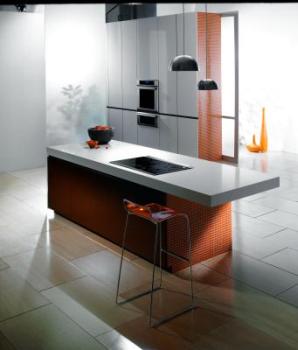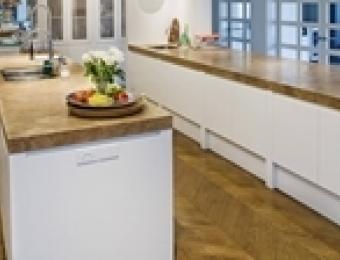
What is a minimalist kitchen?
As the name very sensibly implies, the minimalist kitchen is generally extremely basic, very uncomplicated and features as little visual clutter as possible. A minimalist kitchen generally represents the pinnacle of the modernist kitchen design, and though it functions in a basic sense like a normal kitchen should and contains all of the typical appliances, there's normally not much on show.
Colours and style
A minimalist kitchen's main design features are straight lines and dull-hued colours. In contrast to busier and more ornate styles of kitchens, minimalist kitchens may appear somewhat sterile and lacking in personality, although this assessment largely ignores the point of the style. The idea behind a minimalist kitchen is to highlight and exaggerate the inherent beaty in the simplicity of its shades and subtle lines, as well as in the textures and properties of the materials used.
In most cases, small details like drawer and cupboard handles are done away with in favour of recessed or cutout grabs in cabinets.
Materials used in minimalist kitchens
The materials used are a central feature to most minimalist kitchens. While they look simple, minimalist kitchens are all about splashing out on very high quality materials, and accentuating the aesthetic qualities for which they're so highly prized. Top grade metals, polished concrete, fine timbers and stone are regular ingredients in the best minimalist kitchens. As simple as they look, minimalist kitchens are normally not cheap!
Appliances and lighting
Selections in terms of lighting and appliances are central to maintaining a genuinely minimalist feel. All of the appliances, where they can't be completely concealed, should complement the overall design of the kitchen and not detract from the look with incongruous shapes or colour tones.
Lighting design is also a key consideration - as much as it should err on the side of being minimalist in itself, it also needs to provide task lighting where it's needed, and serves to accentuate and mute other aspects of the kitchen to determine how it looks. Because minimalist kitchens are quite barren by nature, small variations in lighting will make very noticeable differences to the look of the kitchen.
How practical are minimalist kitchens?
To be clear, minimalist kitchens aren't normally designed to be warm, busy family kitchens where children's paintings are stuck on the fridge and stacks of oddly-coloured utensils fill racks next to cooktops. Not only are minimalist kitchens normally too small to accommodate the daily needs of a large family, it's likely that heavy use will also make a tremendous chore of maintaining the minimalist feel.
Truly minimalist kitchens are mostly the preserve of those who have a deep affinity for simplicity in design and high quality materials, and those who loathe any sort of clutter.



